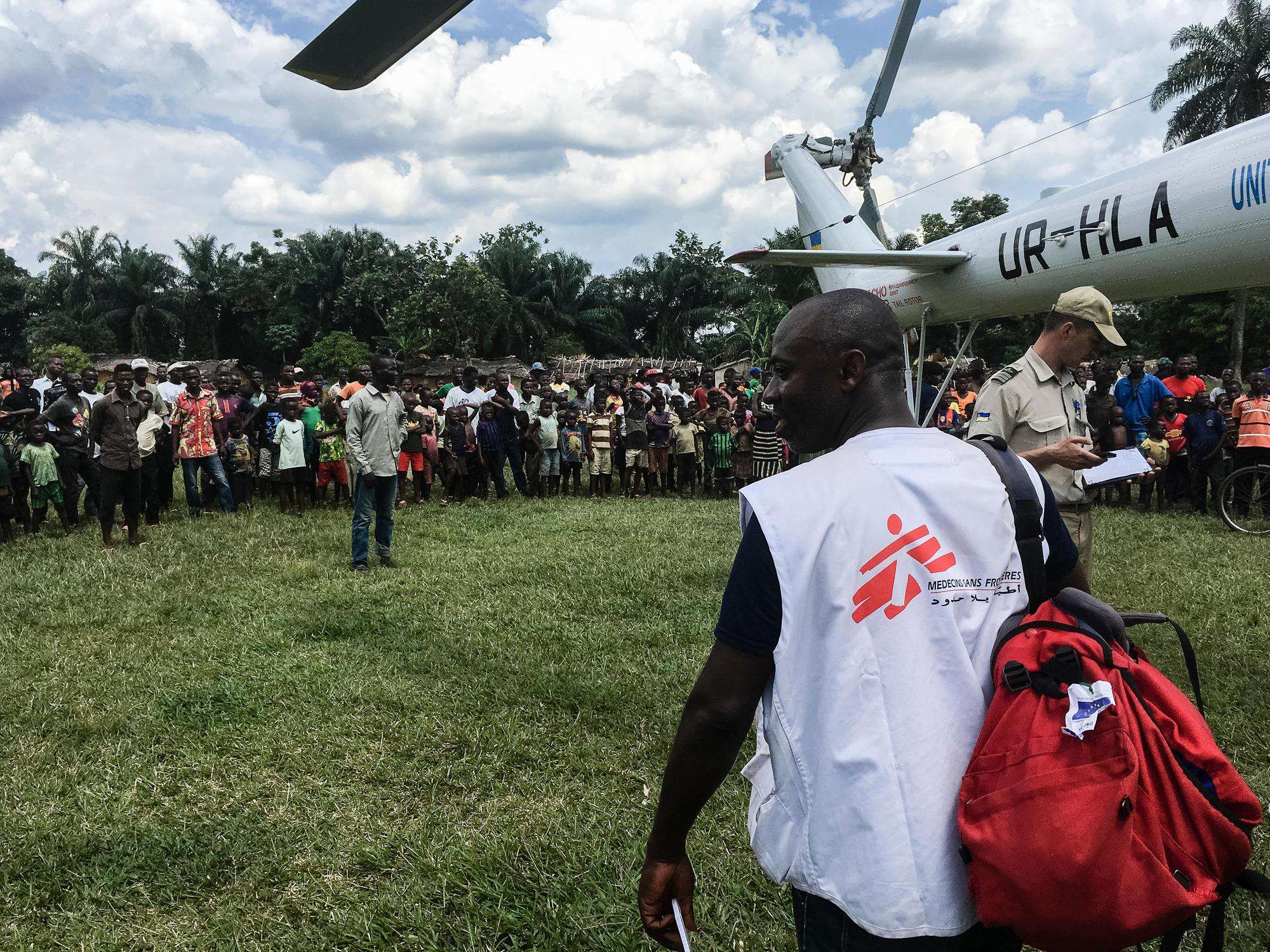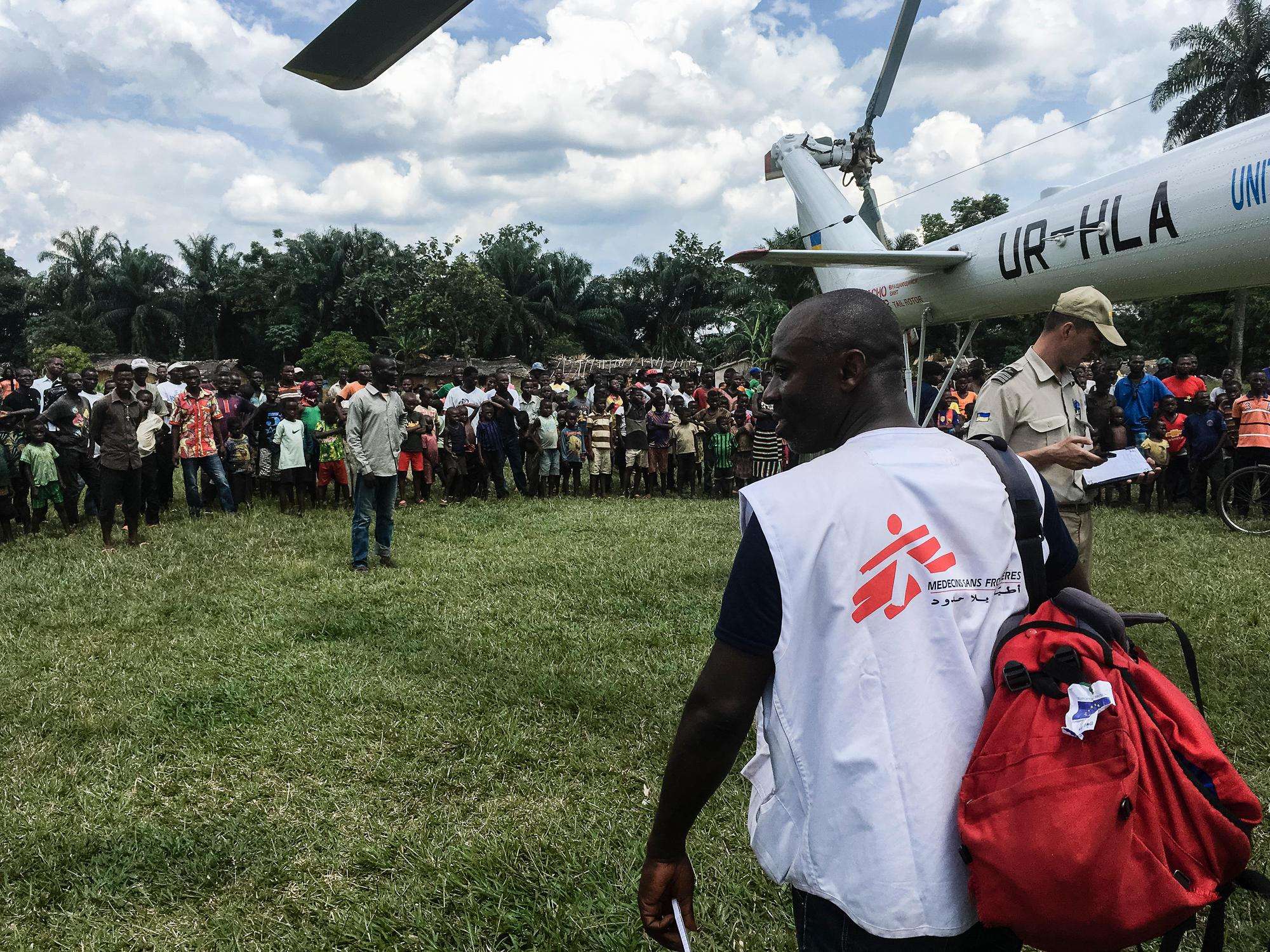Latest figures (source: DRC Ministry of Health, as of June 5, 2018)
Since the Ebola epidemic in Democratic Republic of Congo (DRC) was declared on May 8, 2018, 60 people have presented symptoms of hemorrhagic fever, including 37 confirmed Ebola cases and 27 deaths (of whom 13 were confirmed as Ebola). Twenty-three patients confirmed to have Ebola recovered from the disease and were discharged from treatment centers.
MSF Operations
Staff on the ground: 75 international and 360 national staff
Supplies sent: 100 metric tons
| Suspected cases | Probable cases | Laboratory-confirmed cases | Deaths (confirmed Ebola) | |
| Mbandaka | 1 | 0 | 4 | 3 |
| Bikoro | 2 | 11 | 10 | 7 |
| Iboko | 6 | 3 | 23 | 3 |
| Total | 9 | 14 | 37 | 13 |
The outbreak is currently affecting the city of Mbandaka and the health zones of Bikoro (Bikoro and Ikoko villages) and Iboko (Itipo and Iboko villages). Bikoro, a small city where some Ebola cases have been detected, is approximately four hours’ drive from Mbandaka. Connections with Bikoro are also possible via Lake Tumba, which the local community uses to reach the Congo River.
This is the ninth Ebola outbreak in DRC in the last 40 years. So far, most of the previous outbreaks have occurred in relatively remote and isolated areas, with little spread of the disease. The last Ebola outbreaks in DRC occurred in Likati district in May 2017, with eight people infected, of whom four died, and in Boende (Tshuapa region) in 2014, with 66 people infected and 49 deaths.
With the correct intervention and careful monitoring of the situation, it is possible to limit the spread of the outbreak.
Unlike in previous Ebola outbreaks in DRC, where cases have been concentrated in remote villages, patients have now been diagnosed in Mbandaka, a Congo river port city of more than one million inhabitants. While easy access to transportation routes increases the risk of the virus spreading, surveillance is being reinforced. As of June 5, only four lab-confirmed patients have been identified in Mbandaka. For now, it’s important to emphasize that the epidemic has not spread widely within the city. With the correct intervention and careful monitoring of the situation, it is possible to limit the spread of the outbreak.
During the past few weeks, MSF has been working closely with the Congolese Ministry of Health (MoH) and with other organizations on the ground to coordinate a response based on the “six pillars” of Ebola intervention:
- care of diagnosed patients and isolation;
- outreach activities to find patients;
- tracing and follow-up with patient contacts;
- health promotion activities to inform people about the risks and how to avoid them;
- support of regular health care; and
- safe burials to avoid infections.
MSF and its research unit, Epicentre, are working with the local health authorities and the World Health Organization (WHO) to participate in the implementation of the Ebola vaccine rVSVDG-ZEBOV-GP, which is being used as part of the overall strategy to control the Ebola outbreak.
Since May 21, the WHO have vaccinated 1737 people and since May 28, MSF teams have vaccinated 670 people.
To tackle the Ebola epidemic and limit the spread of the virus, MSF is stepping up its response in the affected areas.
MSF emergency teams are carrying out activities in four locations where suspected and confirmed patients have been identified: Mbandaka, Bikoro, Iboko, and Itipo. We are working in collaboration with DRC’s health ministry and the WHO.
We currently operate three Ebola treatment centers (ETCs) with a total capacity of 45 beds in isolation and one transit center in Itipo with 14 beds. As of June 6, we are caring for 5 patients.
Around 100 metric tons of supplies have been shipped to Kinshasa and dispatched to the affected areas since the beginning of the epidemic. An additional 15 tons are expected to arrive by the end of this week. Materials include medical kits, protection and disinfection kits (isolation items such as gloves, boots, and personal protective equipment), logistics and hygiene kits (plastic sheets, jerry cans, water distribution kits, chlorine spray kits, water treatment kits), drugs, transport (cars and motorbikes), tents, and construction materials for building Ebola treatment centers.
A total of 63 tons of supplies (including six vehicles and 10 motorbikes) have already been sent to Mbandaka and Bikoro, with more to be sent in the coming days.
As part of MSF’s emergency preparedness in DRC, some supplies were already available in Kinshasa. These were sent to hotspot zones as soon as the outbreak started.
MSF’s Ebola response in DRC started on May 5, with an epidemiological alert in the Equateur region. A small team from MSF’s Congo Emergency Pool (PUC) assessed the situation, together with teams from the national Ministry of Health and WHO. When the Ebola epidemic was officially declared on May 8, experts from MSF’s emergency pools arrived in the field to deploy a rapid response in the Ebola hotspots. Among the MSF staff on the ground are some of our most experienced Ebola field workers, including medical personnel, experts in infection control, and logisticians.
Mbandaka
At the beginning of the outbreak, we set up an isolation zone with five beds in Mbandaka’s main hospital (Wangata hospital). An MSF Ebola treatment center with 12 beds was also built and has been operational since May 28. The bed capacity in the ETC can be upgraded to 40 if needed. This will allow the main hospital to refocus on providing non-Ebola health care to the local community. As of June 7 there are no patients in the ETC.
In addition to the treatment and isolation of suspected and confirmed Ebola cases, the focus of MSF’s response is on surveillance, investigation of new cases and contacts, infection control and prevention, health promotion, and training activities.
Bikoro
The team is also intervening in Bikoro, where an MSF ETC with 20 beds has been built, and continues to reinforce outreach activities including investigation of contact cases, monitoring, and surveillance. There are two teams who respond to alerts of suspected and probable cases in the surrounding villages.
Itipo/Iboko
MSF teams are also present in the remote areas of Itipo and Iboko, where suspected and confirmed Ebola cases have been identified. In Itipo, a 14-bed transit center with isolation capacity is already functional. In this transit center, patients with suspected cases of Ebola are isolated and cared for, and samples are taken to confirm the diagnosis. If Ebola is confirmed, patients are transferred to the Bikoro ETC.
In Iboko, an isolation area has been built in the main hospital and the team is constructing an additional ETC.
Vaccination
MSF and its research unit (Epicentre) are working closely with the MoH and the WHO to participate in the implementation of the Ebola vaccine rVSVDG-ZEBOV-GP as an additional measure to control the outbreak. MSF’s Vaccination activities started on May 28 and targeted Bikoro, Itipo, Bokongo, Butela, Ikoko, Impenge and Bolendo. The vaccination is administered according to a "ring vaccination" approach, which targets contacts and contacts of contacts of confirmed Ebola cases. This ensures that the vaccination of people in the contact "ring" create a buffer zone—or protective ring—to prevent the spread of infection. Frontline workers deemed most at risk of coming in contact with the virus (including health workers and hygienists working in ETCs, religious leaders, and traditional healers) have also been offered the vaccine. So far, 670 people have been vaccinated by MSF, and 1737 overall.





